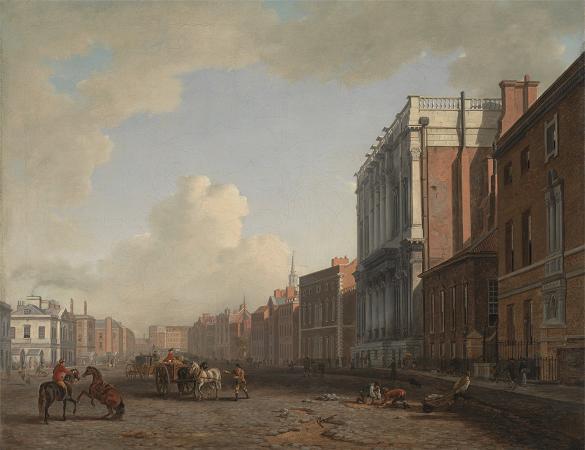Whitehall. The Palace of Whitehall at Westminster, Middlesex, was the main residence of the English monarchs from 1530 until 1698, when most of its structures, except for Inigo Jones's Banqueting House of 1622, were destroyed by fire. It had at one time been the largest palace in Europe, with more than 1,500 rooms, overtaking the Vatican, before itself being overtaken by the expanding Palace of Versailles, which was to reach 2,400 rooms. The palace gives its name, Whitehall, to the street on which many of the current administrative buildings of the present-day British government are situated, and hence metonymically to the central government itself. At its most expansive, the palace extended over much of the area bordered by Northumberland Avenue in the north; to Downing Street and nearly to Derby Gate in the south; and from roughly the elevations of the current buildings facing Horse Guards Road in the west, to the then banks of the River Thames in the east, a total of about 23 acres. It was about 710 yards from Westminster Abbey. By the 13th century, the Palace of Westminster had become the centre of government in England, and had been the main London residence of the king since 1049. The surrounding area became a popular and expensive location. The Archbishop of York Walter de Grey bought a nearby property as his London residence soon after 1240, calling it York Place. King Edward I stayed at York Place on several occasions while work was carried out at Westminster, and enlarged it to accommodate his entourage. York Place was rebuilt during the 15th century and expanded so much by Cardinal Wolsey that it was rivalled by only Lambeth Palace as the greatest house in London, the King's London palaces included. Consequently, when King Henry VIII removed the cardinal from power in 1530, he acquired York Place to replace Westminster as his main London residence, inspecting its possessions in the company of Anne Boleyn. The name Whitehall or White Hall was first recorded in 1532; it had its origins in the white stone used for the buildings. King Henry VIII hired the Flemish artist Anton van den Wyngaerde to redesign York Place, and he extended it during his lifetime. Inspired by Richmond Palace, he included sporting facilities, with a bowling green, indoor real tennis court, a pit for cock fighting and a tiltyard for jousting. It is estimated that more than E 30,000 were spent during the 1540s, half as much again as the construction of the entire Bridewell Palace. Henry VIII married two of his wives at the palace, Anne Boleyn in 1533 and Jane Seymour in 1536, and died there in January 1547. In 1611, the palace hosted the first known performance of William Shakespeare's play The Tempest. James VI and I made significant changes to the buildings, notably the construction in 1622 of a new Banqueting House built to a design by Inigo Jones to replace a series of previous banqueting houses dating from the time of Elizabeth I. Its decoration was finished in 1634 with the completion of a ceiling by Sir Peter Paul Rubens, commissioned by Charles I. By 1650 Whitehall Palace was the largest complex of secular buildings in England, with more than 1,500 rooms. Its layout was irregular, and its constituent parts were of many different sizes and in several different architectural styles, making it look more like a small town than a single building. The irregularity of the buildings was increased by the penchant of courtiers to build onto their assigned lodgings, either at their own expense or that of the King's. Sir Stephen Fox, Charles II's Clerk of the Green Cloth, obtained permission from the Office of Works in the 1660s to build additions to the three rooms he was assigned. By the time he was finished he had constructed a grand mansion with coach house, stables, and a view over the Thames, all within the palace network. Charles II commissioned minor works. Like his father, he died at the palace, but from a stroke. James II ordered various changes by Sir Christopher Wren, including a chapel finished in 1687, rebuilding of the queen's apartments, and the queen's private lodgings. The Catholic chapel of James II, constructed during a period of fierce anti-Catholicism in England, attracted much criticism and also awe when it was completed in December 1686. The ceiling was adorned with 8,132 pieces of gold leaf, and at the east end of the nave an enormous marble altarpiece designed by Wren and carved by Grinling Gibbons dominated the room. The diarist John Evelyn noted that I should not have believed I should ever have seen such things in the King of England's palace, after it pleased God to enlighten this nation. By 1691 the palace had become the largest and most complex in Europe.
more...





